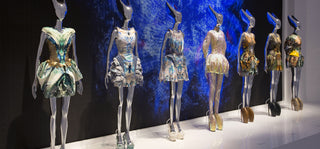From Elsa Schiaparelli and her infamous lobster dress painted by Salvador Dali to contemporary trailblazers such as Cindy Sherman and her self-portraits wearing vintage Chanel, fashion and art have been bouncing ideas off each other for decades. Over the past 20 years, the overlap has become even broader, ranging from a genuine commitment to art to more cynical exercises in brand-building and media exposure.
The reasons for this are complex and manifold, symptomatic of a circular movement which has been creeping across society for the past 20 years. In an age of increased democratisation, luxury has lost its sheen. Inspiration for designers today is frequently drawn from the aesthetic and language of the street, where many of today’s celebrities begin their careers. Museums, too, now focus less on ‘high’ culture and more on popular movements; think of the V&A’s current exhibition You Say You Want a Revolution? Records and Rebels 1966-1970.
Simultaneously, the growth of social media such as Instagram has created an access-all-areas visual culture that thrives on the power of the image. And all of it springs in turn from a desire for greater relevance in today’s society, a yearning to reach different audiences; at its most basic level, it’s driven by a need to make a profit. The traditional silhouettes of couture exist for an increasingly niche market, but the exaggeratedly luxe streetwear of labels like Vetements is more popular than ever; the sudden ubiquity of luxury trainers is testament to that.
When fashion and art come together, they create a mutually beneficial arrangement that sees art exposed to new audiences (not to mention funding) - and to new media and avenues of mass marketings - and lends fashion, always regarded the flightier and more commercial of the two disciplines, with a gravitas and authority it would find hard to achieve on its own.
Art critic Hettie Judah has a long-standing relationship with the Mode Museum in Antwerp and has written extensively on the relationship between fashion and art. ‘> Within the fashion industry there is an abiding perception that artists work free of commercial constraints and the kind of pressure that those in the fashion industry struggle with,’ she says. ‘There is still a popular idea of the artist as a figure of unconstrained, pure expression that has become totemic.
‘Up to a point, that’s true. The fashion industry is voracious, and for any designer to make money, they need to work within established industry constraints. It is notable that both Martin Margiela and Helmut Lang left their successful fashion labels to concentrate on their artwork.’ How do they work together? ‘To an extent these days, both [art and fashion] seem to function as a kind of entertainment and/or spectacle, whether it’s a blockbuster exhibition or an Instagram-ready catwalk show,’ she says.
Collaborations have been the public face of this development. And when collaborations work, they really work. Prada’s presentation demonstrated what can happen when a designer blends visual acuity with passion. The same goes for Belgian designer Raf Simons’ one-off capsule range with American multimedia artist Sterling Ruby: a hype-inducing wardrobe of splattered streetwear, Simon’s minimalist precision blended with Ruby’s anarchic hand-painted exuberance.
Simons’ has good form in mixing with artists: aficionados will recall his previous work featuring Joy Division album art. His Spring/Summer 2016 “Isolated Heroes” collection offers parkas and sweatshirts (no one does luxe streetwear like Simons) emblazoned with monochrome portraits of extraordinarily beautiful young men by photographer David Sims. The sinuous lines of Sims’ images against Simons’ pared down, street-style-infused silhouettes made the partnership one to remember.




